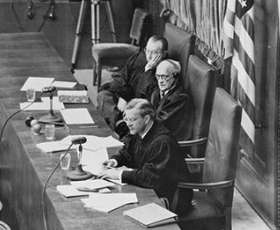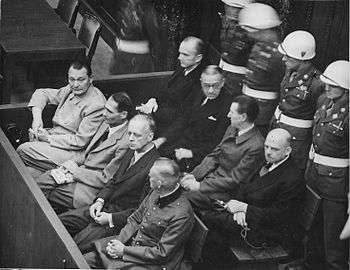Subsequent Nuremberg trials
| Subsequent Nuremberg Trials | |
|---|---|
|
The judges in the Krupp trial; back to front: Daly, Anderson, and Wilkins | |
| Court | Nuremberg |
| Full case name | Trials of War Criminals before the Nuremberg Military Tribunals |
| Indictment | 9 December 1946, Nuremberg |
| Decided | 13 April 1949 (last case) |
The subsequent Nuremberg trials (formally the Trials of War Criminals before the Nuremberg Military Tribunals) were a series of twelve U.S. military tribunals for war crimes against members of the leadership of Nazi Germany, held in the Palace of Justice, Nuremberg, after World War II from 1946 to 1949 following the Trial of the Major War Criminals before the International Military Tribunal.[1]
Background
Although it had been initially planned to hold more than just one international trial at the IMT, the growing differences between the victorious allies (the United States, United Kingdom, France, and Soviet Union) made this impossible. However, the Control Council Law No. 10, which the Allied Control Council had issued on 20 December 1945, empowered any of the occupying authorities to try suspected war criminals in their respective occupation zones. Based on this law, the U.S. authorities proceeded after the end of the initial Nuremberg Trial against the major war criminals to hold another twelve trials in Nuremberg. The judges in all these trials were American, and so were the prosecutors; the Chief of Counsel for the Prosecution was Brigadier General Telford Taylor. In the other occupation zones similar trials took place.[1]
Trials
The twelve U.S. trials before the Nuremberg Military Tribunals (NMT) took place from 9 December 1946 to 13 April 1949.[1] The trials were as follows:
| # | Designations | Dates | Defendants |
|---|---|---|---|
| 1 | Doctors' Trial | 9 December 1946 – 20 August 1947 | 23 Nazi physicians of the Action T4 |
| 2 | Milch Trial | 2 January – 14 April 1947 | Field Marshal Erhard Milch of the Luftwaffe |
| 3 | Judges' Trial | 5 March – 4 December 1947 | 16 Nazi German "racial purity" jurists |
| 4 | Pohl Trial | 8 April – 3 November 1947 | Oswald Pohl and 17 SS officers |
| 5 | Flick Trial | 19 April – 22 December 1947 | Friedrich Flick and 5 directors of his companies |
| 6 | IG Farben Trial | 27 August 1947 – 30 July 1948 | directors of IG Farben, maker of Zyklon B |
| 7 | Hostages Trial | 8 July 1947 – 19 February 1948 | 12 German generals of the Balkan Campaign |
| 8 | RuSHA Trial | 20 October 1947 – 10 March 1948 | 14 racial cleansing and resettlement officials |
| 9 | Einsatzgruppen Trial | 29 September 1947 – 10 April 1948 | 24 officers of Einsatzgruppen |
| 10 | Krupp Trial | 8 December 1947 – 31 July 1948 | 12 directors of the Krupp Group |
| 11 | Ministries Trial | 6 January 1948 – 13 April 1949 | 21 officials of Reich ministries |
| 12 | High Command Trial | 30 December 1947 – 28 October 1948 | 14 High Command generals |
Result
In total, 142 of the 185 defendants were found guilty of at least one of the charges. 24 persons received death sentences, of which 11 were subsequently converted into life sentences; 20 were sentenced to life imprisonment, 98 were handed down sentences of varying lengths, and 35 were acquitted. Four defendants had to be removed from trials due to illness, and four more committed suicide during the trials.
Many of the longer prison sentences were reduced substantially by decree of high commissioner John J. McCloy in 1951, and 10 outstanding death sentences from the Einsatzgruppen Trial were converted to prison terms. The same year, an amnesty released many of those who had received prison sentences.
Criticism
Some of the NMTs have been criticised for their conclusion that "moral bombing" of civilians, including its nuclear variety, was legal, and for their judgement that, in certain situations, executing civilians in reprisal was permissible.[2]
Conduct of the prosecution
In a 2005 interview for the Washington Post, Benjamin B. Ferencz, Chief Prosecutor for the United States Army at the Einsatzgruppen Trial, revealed some of his activities during his period in Germany. "Someone who was not there could never really grasp how unreal the situation was," he said. The Americans delivered at least a dozen low-ranking German SS suspects to displaced persons camps for the purpose of having them executed by the DPs ("displaced persons"), without prior trial or sentencing. Under military law at that time, it was legal to hand over suspects to their victims for further questioning.[3]
- "I once saw DPs beat an SS man and then strap him to the steel gurney of a crematorium. They slid him in the oven, turned on the heat and took him back out. Beat him again, and put him back in until he was burnt alive. I did nothing to stop it. I suppose I could have brandished my weapon or shot in the air, but I was not inclined to do so. Does that make me an accomplice to murder?"[3]
In the interview, Ferencz also pointed out that the military legal norms at the time permitted actions that would not be possible today.
- "You know how I got witness statements? I'd go into a village where, say, an American pilot had parachuted and been beaten to death and line everyone up against the wall. Then I'd say, 'Anyone who lies will be shot on the spot.' It never occurred to me that statements taken under duress would be invalid."[3]
See also
- Auschwitz Trial held in Kraków, Poland in 1947 against 40 SS-staff of the Auschwitz concentration camp death factory
- Frankfurt Auschwitz Trials, 1963–65
- Majdanek Trials, the longest Nazi war crimes trial in history, spanning over 30 years
- Chełmno Trials of the Chełmno extermination camp personnel, held in Poland and in Germany. The cases were decided almost twenty years apart
- Sobibor Trial held in Hagen, Germany in 1965, concerning the Sobibor extermination camp
- Belzec Trial before the 1st Munich District Court in the mid-1960s, eight SS-men of the Belzec extermination camp
- Belsen Trial in Lüneburg, 1945
- Command responsibility doctrine of hierarchical accountability
- Dachau Trials held within the walls of the former Dachau concentration camp, 1945–1948
- Mauthausen-Gusen camp trials, 1946–47
- Ravensbrück Trial
- Research Materials: Max Planck Society Archive
References
- 1 2 3 Kevin Jon Heller (2011). The Trials. Introduction: the indictments, biographical information, and the verdicts. The Nuremberg Military Tribunals and the Origins of International Criminal Law. Oxford University Press. pp. 85–. Retrieved 10 January 2015.
- ↑ Heller, Kevin Jon (2011). The Nuremberg Military Tribunals and the Origins of International Criminal Law. Oxford: Oxford University Press. p. 3.
- 1 2 3 Brzezinski, Matthew (24 July 2005). "Giving Hitler Hell". The Washington Post. Retrieved 6 October 2012.
Further reading
- Dubois, Josiah E. (1952). The Devil's Chemists (PDF). Boston, MA: Beacon Press. ASIN B000ENNDV6.
- Priemel, Kim C., and Alexa Stiller, eds. Reassessing the Nuremberg Military Tribunals: Transitional Justice, Trial Narratives, and Historiography (Berghahn Books; 2012) 321 pages
External links
- The NMT proceedings at the Mazal Library.
- An overview.

